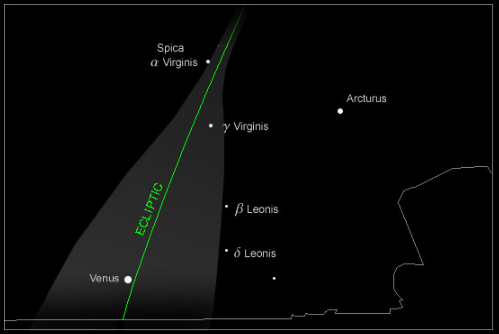Zodiacal Light from Paranal Observatory, Chile
Zodiacal Light from Paranal Observatory, Chile: A Spectacular Celestial Phenomenon
The Zodiacal Light is a mesmerizing celestial phenomenon that can be observed from various locations on Earth. One such location is the ESO Paranal Observatory, nestled in the Atacama Desert in Chile. This remote and pristine site provides ideal conditions for capturing the beauty of the Zodiacal Light, as demonstrated by Yuri Beletsky's stunning photograph taken in July '07.
The Zodiacal Light is caused by sunlight scattering off tiny dust particles within a disk that lies approximately in the same plane as Earth's orbit around the sun. This dusty disk, known as the zodiacal cloud, extends throughout the solar system and is thought to consist of remnants from comets and asteroid collisions. As Earth moves along its orbit, the scattered light from these dust particles becomes visible along the ecliptic, which is marked by the path of the sun against the stars.
When the photograph was taken at the Paranal Observatory, the ecliptic was steeply inclined to the horizon, creating an optimal viewing angle for capturing the Zodiacal Light. Additionally, the absence of the Milky Way in the background further enhanced the visibility of this ethereal phenomenon. The combination of these ideal conditions allowed Yuri Beletsky to capture a truly remarkable image that showcases the awe-inspiring beauty of the Zodiacal Light.
The Paranal Observatory's location in the Atacama Desert contributes to its suitability for observing atmospheric optics phenomena such as the Zodiacal Light. The desert's high altitude, clear skies, and minimal light pollution create an optimal environment for astronomers and astrophotographers alike. This remote and arid region is renowned for its exceptional atmospheric clarity, making it a haven for studying celestial objects and capturing their splendor.
The Zodiacal Light is not only a captivating sight but also holds scientific significance. By studying its characteristics and variations, scientists can gain insights into the composition and dynamics of the zodiacal cloud. Understanding the properties of these dust particles can provide valuable information about the formation and evolution of our solar system. Furthermore, investigating the Zodiacal Light helps scientists refine models of interplanetary dust distribution, which is crucial for space missions and satellite operations.
To fully appreciate the Zodiacal Light, it is best observed during specific times and conditions. The optimal viewing periods are during twilight, just before sunrise or after sunset when the sky is dark but still illuminated by the sun's residual light. It is advisable to find a location away from urban areas and sources of light pollution to ensure a clear and unobstructed view. Patience is key when observing the Zodiacal Light, as its visibility can vary depending on factors such as atmospheric conditions, time of year, and proximity to the ecliptic.
In conclusion, the Zodiacal Light observed from the Paranal Observatory in Chile is a breathtaking spectacle that showcases the beauty and wonder of our universe. The ideal conditions provided by the observatory's location in the Atacama Desert allow for remarkable photographs like Yuri Beletsky's. Studying this celestial phenomenon not only deepens our understanding of the solar system's composition but also offers insights into interplanetary dust distribution. Whether you are an astronomy enthusiast or simply appreciate the wonders of nature, witnessing the Zodiacal Light is an experience that will leave you in awe of the vastness and grandeur of the cosmos.

The Zodiacal Light Photographed in July '07 by Yuri Beletsky at the ESO Paranal Observatory high in the Atacama Desert, Chile.
The dust disk producing the zodiacal light lies approximately in the same plane as that of Earth's orbit around the sun. The latter is marked in the sky as the ecliptic, the path of the sun against the stars. The scattered light from the dust therefore appears along the ecliptic.
This image was taken when the eclip.tic was inclined steeply to the horizon and when the Milky Way was not in the background ~ ideal conditions.
Image ©Yuri Beletsky, shown with permission.

Note: this article has been automatically converted from the old site and may not appear as intended. You can find the original article here.
Reference Atmospheric Optics
If you use any of the definitions, information, or data presented on Atmospheric Optics, please copy the link or reference below to properly credit us as the reference source. Thank you!
-
<a href="https://atoptics.co.uk/blog/zodiacal-light-from-paranal-observatory-chile/">Zodiacal Light from Paranal Observatory, Chile</a>
-
"Zodiacal Light from Paranal Observatory, Chile". Atmospheric Optics. Accessed on November 26, 2024. https://atoptics.co.uk/blog/zodiacal-light-from-paranal-observatory-chile/.
-
"Zodiacal Light from Paranal Observatory, Chile". Atmospheric Optics, https://atoptics.co.uk/blog/zodiacal-light-from-paranal-observatory-chile/. Accessed 26 November, 2024
-
Zodiacal Light from Paranal Observatory, Chile. Atmospheric Optics. Retrieved from https://atoptics.co.uk/blog/zodiacal-light-from-paranal-observatory-chile/.